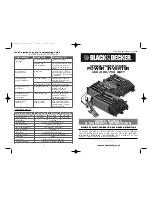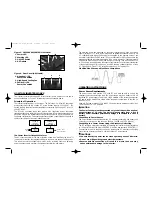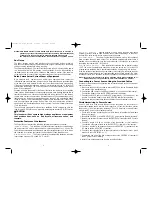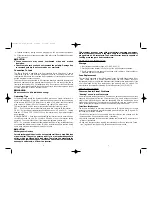
7
This problem does not occur with most battery-operated equipment.
Most of these devices use a separate charger or transformer that is
plugged into an AC receptacle. The Power Inverter is easily capable of
running most chargers and transformers.
CARE AND MAINTENANCE
Storage
1. Ideal storage temperature range is 50-68°F (10-20°C).
2. Store and use the inverter in a cool, dry place with adequate ventilation.
3. Avoid locations that are exposed to heating units, radiators, direct sunlight or
excessive humidity or dampness.
Fuse Replacement
This inverter is equipped with multiple internal fuses. Normally, these fuses will not
“blow” unless there is a serious problem inside the unit. Internal fuses are
replaceable; however, only trained personnel should attempt fuse replacement. If the
unit is damaged during fuse replacement, the warranty may be voided. The
manufacturer recommends contacting Technical Support at (800)-618-5178.
TROUBLESHOOTING
Common Audio/Visual Problems
“Buzzing” sound in audio systems
Some inexpensive stereo systems and “boom boxes” emit a buzzing sound from their
speakers when operated from the Power Inverter. This occurs because the power
supply in the electronic device does not adequately filter the modified sine wave
produced by the inverter. The only solution to this problem is to use a higher quality
sound system that incorporates a higher quality power amplified supply.
Television Interference
The Inverter is shielded to minimize interference with TV signals. However, in some
instances, some interference may still be visible, particularly with weak TV signals. Try
the following corrective measures:
• Position the inverter as far as possible from the television, the antenna and the
antenna cables. Use an extension cable, if necessary
• Adjust the orientation of the inverter, the antenna cables and the TV power cord to
minimize interference
• Make sure that the antenna feeding the television provides an adequate (“snow
free”) signal and that high quality, shielded antenna cable is used
6
9. Test the inverter by turning it on and plugging in a 100 watt lamp or equipment.
10. If the inverter is not properly operating, then refer to the Troubleshooting section
of this manual.
CAUTION
• Loose connectors may cause overheated wires and melted
insulation.
• Check to make sure you have not reversed the polarity. Damage due
to reversed polarity is not covered by our warranty.
Connection To Load
The Power Inverter is equipped with dual standard North American AC power
receptacles. Plug the cord from the equipment you wish to operate into the AC
receptacle(s). Make sure the combined load requirement of your equipment does not
exceed maximum continuous power.
The Power Inverter is engineered to be connected directly to standard electrical and
electronic equipment in the manner described above. Do not connect the Power
Inverter to household or RV AC distribution wiring. Do not connect the Power Inverter
to any AC load circuit in which the neutral conductor is connected to ground (earth)
or to the NEGATIVE of the DC (battery) source.
WARNING
Do not connect to AC distribution wiring!
Operating Tips
For best operating results, the inverter should be placed on a stable, flat surface. A
power cord measuring 2 feet (0.61 meters) has been provided for easy positioning
of the inverter. (VEC1045/46 features a clip cable of 0.9 meter, vehicle accessory
plug cable of 0.6 meter; VEC1047 features a clip cable of 0.9 meters only.)
The inverter should only be used in locations that meet the following criteria:
DRY — Do not allow water or other liquids to come into contact with the inverter.
COOL — Surrounding air temperature should be between –0°C and 40°C — ideally
between 15°C and 25°C (60-80°F). Keep the inverter away from direct sunlight,
when possible.
WELL-VENTILATED — Keep the area surrounding the inverter clear to ensure free air
circulation around the unit. Do not place items on or over the inverter during
operation. The unit will shut down if the internal temperature gets too hot.
SAFE — Do not use the inverter near flammable materials or in any locations that may
accumulate flammable fumes or gases. This is an electrical appliance that can briefly
spark when electrical connections are made or broken.
CAUTION
Rechargeable Devices
Certain rechargeable devices do not operate well from a modified sine
wave inverter. They only operate properly from a standard household
outlet, which provides a pure sine wave. Therefore, the manufacturer
recommends that these types of devices be operated from a standard
household outlet only, not from the inverter.
VEC1045_46_47_BD_Manual 4/28/05 5:16 PM Page 6
























